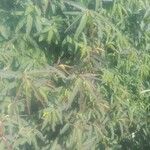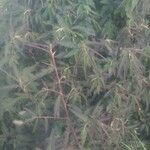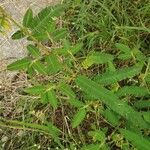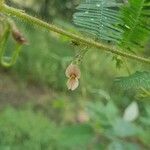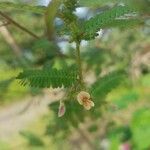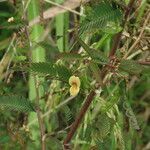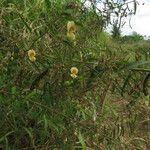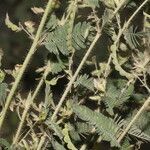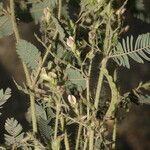Herbs or shrublets, (0.4-)1.5-2 m tall. Stems erect, many branched, glabrous, viscid. Stipules lanceolate, 10-12 × 1-3 mm, membranous, base auriculate, apex acute. Leaves 30-40-foliolate; leaflet blades linear-oblong, 8-10 × 2-4 mm, papery, primary veins 2-4, base oblique, apex obtuse and mucronate. Inflorescences axillary, racemose, laxly branched, 2-4-flowered; bracts cordate, membranous. Bracteoles linear-ovate, striate. Calyx deeply 2-lobed. Corolla yellow, ca. 7 mm. Legume oblong, 2.5-3 cm × 2.5-3 mm, herbaceous to leathery, slightly curved, abaxial suture undulate and indented; articles 4-7, rounded, slightly muricate. Seeds brown, reniform. Fl. and fr. Oct-Nov.
Leaves 2–7 cm long, c. 20–60-foliolate, the petiole and rhachis hispidulous; leaflets glabrous, 2–several-costate, ciliate, 4–15 × 1–2 mm, subfalcate, apiculate, the base asymmetrically rounded; stipules peltate-appendiculate, glabrous or somewhat hispid at the point of attachment, striate, usually ciliate, (5)10–25 × 1–4 mm, the upper portion attenuate, 2–3 times longer than the lower acute or erose portion.
Fruit 2–3 cm long, 3–9-articulate, the stipe c. 2 mm long, the articles semicircular, the upper margin essentially straight, the lower curved, 3–6 × 2.5–5 mm, glandular-hispidulous, or glabrous or nearly so, usually muricate, the margins thickened, reticulate-veined; seeds dark brown, 2–3 × 1.5–2 mm.
Inflorescences axillary, racemose, few-flowered, the axes hispidulous; bracts c. 2–4 × 2–3 mm, cordate, acuminate or, sometimes, truncate-flabelliform, glabrous, ciliate; bracteoles 2–4 × 1–1.5 mm, linear to linear-ovate, acute to acuminate, serrate-ciliate.
Corolla yellowish to tan, usually with red or purplish lines, glabrous.
Calyx glabrous to hispidulous, bilabiate, 3–6 mm long.
Erect or decumbent herb, 0.3–1.5(2) m tall.
Stems glandular-hispid to subglabrous.
A half-woody shrub about 3 ft. high
Leaves sensitive to touch.
Flowers c. 5–10 mm long.
Pink flowers
